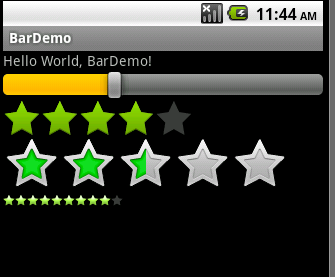在編寫Android程序的時候,我們總是難免會碰到OOM(OUT OF MEMORY)的錯誤,那麼這個錯誤究竟是怎麼來的呢,可以先看一下這篇文章android BITMAP內存限制OOM,OUT OF MEMORY。
這裡,我使用Gallery來舉例,在模擬器中,不會出現OOM錯誤,但是,一旦把程序運行到真機裡,圖片文件一多,必然會出現OOM,我們通過做一些額外的處理來避免。
1.創建一個圖片緩存對象HashMap dataCache,integer對應Adapter中的位置position,我們只用緩存處在顯示中的圖片,對於之外的位置,如果dataCache中有對應的圖片,我們需要進行回收內存。在這個例子中,Adapter對象的getVIEw方法首先判斷該位置是否有緩存的bitmap,如果沒有,則解碼圖片(bitmapDecoder.getPhotoItem,BitmapDecoder類見後面)並返回bitmap對象,設置dataCache 在該位置上的bitmap緩存以便之後使用;若是該位置存在緩存,則直接取出來使用,避免了再一次調用底層的解碼圖像需要的內存開銷。有時為了提高 Gallery的更新速度,我們還可以預存儲一些位置上的bitmap,比如存儲顯示區域位置外向上3個向下3個位置的bitmap,這樣上或下滾動 Gallery時可以加快getVIEw的獲取。
- public View getView(int position, View convertView, VIEwGroup parent) {
-
- if(convertVIEw==null){
- LayoutInflater inflater = LayoutInflater.from(context);
- convertVIEw = inflater.inflate(R.layout.photo_item, null);
- holder = new VIEwHolder();
- holder.photo = (ImageView) convertView.findVIEwById(R.id.photo_item_image);
- holder.photoTitle = (TextView) convertView.findVIEwById(R.id.photo_item_title);
- holder.photoDate = (TextView) convertView.findVIEwById(R.id.photo_item_date);
- convertVIEw.setTag(holder);
- }else {
- holder = (ViewHolder) convertVIEw.getTag();
- }
- cursor.moveToPosition(position);
-
- Bitmap current = dateCache.get(position);
- if(current != null){//如果緩存中已解碼該圖片,則直接返回緩存中的圖片
- holder.photo.setImageBitmap(current);
- }else {
- current = bitmapDecoder.getPhotoItem(cursor.getString(1), 2) ;
- holder.photo.setImageBitmap(current);
- dateCache.put(position, current);
- }
- holder.photoTitle.setText(cursor.getString(2));
- holder.photoDate.setText(cursor.getString(4));
- return convertVIEw;
- }
-
- }
BitmapDecoder.class
- package com.wuyi.bestjoy;
- import Java.io.FileNotFoundException;
- import Java.io.FileOutputStream;
- import android.content.Context;
- import android.graphics.Bitmap;
- import android.graphics.BitmapFactory;
- import android.graphics.Matrix;
- public class BitmapDecoder {
- private static final String TAG = "BitmapDecoder";
- private Context context;
- public BitmapDecoder(Context context) {
- this.context = context;
- }
-
- public Bitmap getPhotoItem(String filepath,int size) {
- BitmapFactory.Options options = new BitmapFactory.Options();
- options.inSampleSize=size;
- Bitmap bitmap = BitmapFactory.decodeFile(filepath,options);
- bitmap=Bitmap.createScaledBitmap(bitmap, 180, 251, true);//預先縮放,避免實時縮放,可以提高更新率
- return bitmap;
-
- }
- }
2.由於Gallery控件的特點,總有一個item處於當前選擇狀態,我們利用此時進行dataCache中額外不用的bitmap的清理,來釋放內存。
- @Override
- public void onItemSelected(AdapterView<?> parent, View vIEw, int position,long id) {
-
- releaseBitmap();
- Log.v(TAG, "select id:"+ id);
- }
- private void releaseBitmap(){
- //在這,我們分別預存儲了第一個和最後一個可見位置之外的3個位置的bitmap
- //即dataCache中始終只緩存了(M=6+Gallery當前可見vIEw的個數)M個bitmap
- int start = mGallery.getFirstVisiblePosition()-3;
- int end = mGallery.getLastVisiblePosition()+3;
- Log.v(TAG, "start:"+ start);
- Log.v(TAG, "end:"+ end);
- //釋放position<start之外的bitmap資源
- Bitmap delBitmap;
- for(int del=0;del<start;del++){
- delBitmap = dateCache.get(del);
- if(delBitmap != null){
- //如果非空則表示有緩存的bitmap,需要清理
- Log.v(TAG, "release position:"+ del);
- //從緩存中移除該del->bitmap的映射
- dateCache.remove(del);
- delBitmap.recycle();
- }
- }
- freeBitmapFromIndex(end);
-
- }
-
- /**
- * 從某一位置開始釋放bitmap資源
- * @param index
- */
- private void freeBitmapFromIndex(int end) {
- //釋放之外的bitmap資源
- Bitmap delBitmap;
- for(int del =end+1;del<dateCache.size();del++){
- delBitmap = dateCache.get(del);
- if(delBitmap != null){
- dateCache.remove(del);
- delBitmap.recycle();
- Log.v(TAG, "release position:"+ del);
- }
-
- }
- }
經過這些額外的操作,有效的避免了OOM的問題。
 Android開發之SeekBar和RatingBar
Android開發之SeekBar和RatingBar
 開啟/關閉/監聽 飛行模式
開啟/關閉/監聽 飛行模式
 Android AIDL全攻略一
Android AIDL全攻略一
 Android開發教程之高煥堂-上課講義(6)
Android開發教程之高煥堂-上課講義(6)